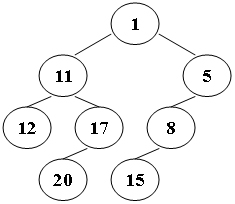PAT 1127 ZigZagging on a Tree[难]
1127 ZigZagging on a Tree (30 分)
Suppose that all the keys in a binary tree are distinct positive integers. A unique binary tree can be determined by a given pair of postorder and inorder traversal sequences. And it is a simple standard routine to print the numbers in level-order. However, if you think the problem is too simple, then you are too naive. This time you are supposed to print the numbers in "zigzagging order" -- that is, starting from the root, print the numbers level-by-level, alternating between left to right and right to left. For example, for the following tree you must output: 1 11 5 8 17 12 20 15.

Input Specification:
Each input file contains one test case. For each case, the first line gives a positive integer N (≤30), the total number of nodes in the binary tree. The second line gives the inorder sequence and the third line gives the postorder sequence. All the numbers in a line are separated by a space.
Output Specification:
For each test case, print the zigzagging sequence of the tree in a line. All the numbers in a line must be separated by exactly one space, and there must be no extra space at the end of the line.
Sample Input:
8
12 11 20 17 1 15 8 5
12 20 17 11 15 8 5 1
Sample Output:
1 11 5 8 17 12 20 15题目大意:给出二叉树的中根遍历和后根遍历序列,给出zigzag遍历序列,就是隔层从左到右,从右到左这样转换遍历。
//这个我当然是不会了,好久没做二叉树的题目了。
转自:https://www.liuchuo.net/archives/3758
#include <iostream>
#include <vector>
#include <queue>
#include<cstdio>
using namespace std;
vector<int> in, post, result[];
int n, tree[][], root;
struct node {
int index, depth;//保存index和深度。
};
//将二叉树的结构存储在了tree中。
void dfs(int &index, int inLeft, int inRight, int postLeft, int postRight) {
if (inLeft > inRight) return;
index = postRight;//进来之后再赋值,真的厉害。
int i = ;
while (in[i] != post[postRight]) i++;
dfs(tree[index][], inLeft, i - , postLeft, postLeft + (i - inLeft) - );
dfs(tree[index][], i + , inRight, postLeft + (i - inLeft), postRight - );
}
//dfs函数得到的root实际上是post遍历中的下标。
void bfs() {
queue<node> q;
q.push(node{root, });
while (!q.empty()) {
node temp = q.front();
q.pop();
result[temp.depth].push_back(post[temp.index]);
if (tree[temp.index][] != )//左子树不为空。
q.push(node{tree[temp.index][], temp.depth + });
//那么此时push进的是左子树,并且深度+1.
if (tree[temp.index][] != )//右子树不为空。
q.push(node{tree[temp.index][], temp.depth + });
}
}
int main() {
cin >> n;
in.resize(n + ), post.resize(n + );
for (int i = ; i <= n; i++) cin >> in[i];//输入中序遍历
for (int i = ; i <= n; i++) cin >> post[i];//输入后序遍历
dfs(root, , n, , n);//将根存在了root中。
bfs();
printf("%d", result[][]);
for (int i = ; i < ; i++) {
if (i % == ) {
for (int j = ; j < result[i].size(); j++)
printf(" %d", result[i][j]);
} else {
for (int j = result[i].size() - ; j >= ; j--)
printf(" %d", result[i][j]);
}
}
return ;
}
//柳神真厉害。
1.使用dfs在遍历的过程中传进去index引用参数,直接赋值,并且使用tree二维数组存储二叉树的结构
2.使用结构体node,存储下标和层数,下标是在post序列中可以寻到节点的。
3.对奇数层和偶数层,分别用不同的方式打印。
代码来自:https://www.cnblogs.com/chenxiwenruo/p/6506517.html
#include <iostream>
#include <cstdio>
#include <algorithm>
#include <string.h>
#include <string>
#include <map>
#define LEFT 0
#define RIGHT 1
using namespace std;
const int maxn=;
int inorder[maxn];
int postorder[maxn];
int level[maxn][maxn]; //每层的节点id
int levelcnt[maxn]; //每层的节点个数
int maxlayer=;
int cnt=; //节点id
struct Node{
int left=-,right=-;
int val;
}node[maxn]; //根据中序遍历和后序遍历建立树
void build(int inL,int inR,int postL,int postR,int fa,int LorR){
if(inL>inR)
return;
int val=postorder[postR];
int idx;
//在中序遍历中找出父亲节点的索引,其左边是左子树,右边是右子树
for(int i=inL;i<=inR;i++){
if(inorder[i]==val){
idx=i;
break;
}
}
int lnum=idx-inL;//左子树的节点个数
cnt++;
node[cnt].val=val;
if(LorR==LEFT)
node[fa].left=cnt;
else if(LorR==RIGHT)
node[fa].right=cnt;
int tmp=cnt;
build(inL,idx-,postL,postL+lnum-,tmp,LEFT);
//这里的left标志是当前深度遍历中是左子树还是右子树。
build(idx+,inR,postL+lnum,postR-,tmp,RIGHT);
}
void dfs(int root,int layer){
if(root==-)
return;
maxlayer=max(layer,maxlayer);
level[layer][levelcnt[layer]]=root;
levelcnt[layer]++;
dfs(node[root].left,layer+);
dfs(node[root].right,layer+);
}
int main()
{
int n;
cin>>n;
for(int i=;i<=n;i++)
cin>>inorder[i];
for(int i=;i<=n;i++)
cin>>postorder[i];
build(,n,,n,-,-);
dfs(,);
bool flag=true;
printf("%d",node[].val);
for(int i=;i<=maxlayer;i++){
if(flag){
for(int j=;j<levelcnt[i];j++)
printf(" %d",node[level[i][j]].val);
}
else{
for(int j=levelcnt[i]-;j>=;j--)
printf(" %d",node[level[i][j]].val);
}
flag=!flag;
}
return ;
}
1.这个是使用函数建树,具体的代码理解在代码里。
PAT 1127 ZigZagging on a Tree[难]的更多相关文章
- PAT 1127 ZigZagging on a Tree
Suppose that all the keys in a binary tree are distinct positive integers. A unique binary tree can ...
- PAT甲级1127. ZigZagging on a Tree
PAT甲级1127. ZigZagging on a Tree 题意: 假设二叉树中的所有键都是不同的正整数.一个唯一的二叉树可以通过给定的一对后序和顺序遍历序列来确定.这是一个简单的标准程序,可以按 ...
- PAT甲级 1127. ZigZagging on a Tree (30)
1127. ZigZagging on a Tree (30) 时间限制 400 ms 内存限制 65536 kB 代码长度限制 16000 B 判题程序 Standard 作者 CHEN, Yue ...
- pat 甲级 1127. ZigZagging on a Tree (30)
1127. ZigZagging on a Tree (30) 时间限制 400 ms 内存限制 65536 kB 代码长度限制 16000 B 判题程序 Standard 作者 CHEN, Yue ...
- 1127 ZigZagging on a Tree (30 分)
1127 ZigZagging on a Tree (30 分) Suppose that all the keys in a binary tree are distinct positive in ...
- PAT 甲级 1127 ZigZagging on a Tree
https://pintia.cn/problem-sets/994805342720868352/problems/994805349394006016 Suppose that all the k ...
- PAT Advanced 1127 ZigZagging on a Tree (30) [中序后序建树,层序遍历]
题目 Suppose that all the keys in a binary tree are distinct positive integers. A unique binary tree c ...
- PAT甲题题解-1127. ZigZagging on a Tree (30)-中序、后序建树
根据中序遍历和前序遍历确定一棵二叉树,然后按“层次遍历”序列输出.输出规则:除根节点外,接下来每层的节点输出顺序是:先从左到右,再从右到左,交替输出 #include <iostream> ...
- PAT A1127 ZigZagging on a Tree (30 分)——二叉树,建树,层序遍历
Suppose that all the keys in a binary tree are distinct positive integers. A unique binary tree can ...
随机推荐
- Oracle中的三种循环(For、While、Loop)
from:http://jingyan.baidu.com/article/c275f6ba38036ae33c756773.html GOTO用法,以下是SQL源码: DECLARE x numb ...
- BEGINNING SHAREPOINT® 2013 DEVELOPMENT 第14章节--使用Office Services开发应用程序 WOPI和新的Office Web Apps Server
BEGINNING SHAREPOINT® 2013 DEVELOPMENT 第14章节--使用Office Services开发应用程序 WOPI和新的Office Web Apps Server ...
- eclipse不能自动编译XX.java为XX.classs
问题描述:eclipse不能自动编译XX.java为XX.classs 原因:今天下午写代码,因为需要引入jstl包,引入后发现原来项目中已经引入了,然后我又把包删除了,忘记删除java build ...
- abs()
abs() 用于返回一个数值的绝对值 In [1]: abs(10) Out[1]: 10 In [2]: abs(-10) Out[2]: 10 In [3]: abs(-10.9) Out[3]: ...
- XMPP HTTP
1.TCP连接 要想明白Socket连接,先要明白TCP连接.手机能够使用联网功能是因为手机底层实现了TCP/IP协议,可以使手机终端通过无线网络建立TCP连接.TCP协议可以对上层网络提供接口,使上 ...
- 关于HTML5的十大面试题
1.html5的文档类型和字符集分别是什么? 答:<!doctype html>/<meta charset="UTF-8"> 2.在html5中如何嵌入一 ...
- hive 客户端执行select count(1) from t_sz01
yarn-site.xml配置错误 yarn.nodemanager.aux-services 中的-原先配置为_ 导致错误......
- java基础---->多线程之priority(四)
线程的priority能告诉调度程序其重要性如何,今天我们通过实例来学习一下java多线程中的关于优先级的知识.我从没被谁知道,所以也没被谁忘记.在别人的回忆中生活,并不是我的目的. java多线程的 ...
- css - Position定位属性与层级关系
今天同事发现一个有意思的问题,关于position的层级关系的,他要不说我也没注意过 测试后果然有趣,有待深入研究: <!DOCTYPE html> <html> <he ...
- BOM history对象
history对象的三个可用方法和一个属性 back();后退 forward();前进 go(n);跳到第几个页面,负数为后退,正数为前进 length属性,获取缓存的页面的数量 安全性考虑,his ...
